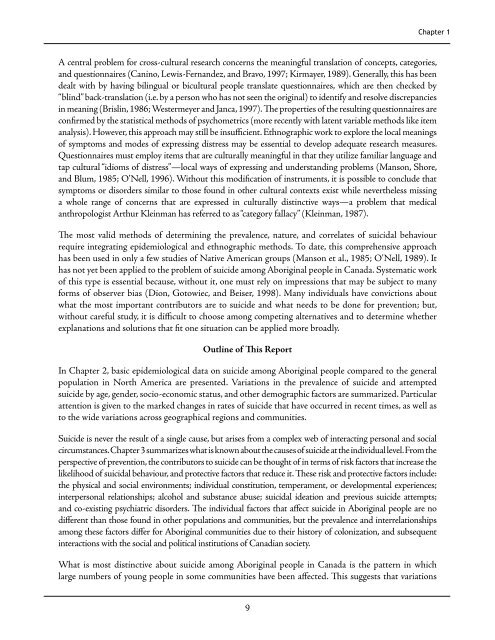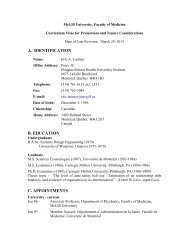Suicide Among Aboriginal People in Canada - Institut universitaire ...
Suicide Among Aboriginal People in Canada - Institut universitaire ...
Suicide Among Aboriginal People in Canada - Institut universitaire ...
Create successful ePaper yourself
Turn your PDF publications into a flip-book with our unique Google optimized e-Paper software.
Chapter 1A central problem for cross-cultural research concerns the mean<strong>in</strong>gful translation of concepts, categories,and questionnaires (Can<strong>in</strong>o, Lewis-Fernandez, and Bravo, 1997; Kirmayer, 1989). Generally, this has beendealt with by hav<strong>in</strong>g bil<strong>in</strong>gual or bicultural people translate questionnaires, which are then checked by“bl<strong>in</strong>d” back-translation (i.e. by a person who has not seen the orig<strong>in</strong>al) to identify and resolve discrepancies<strong>in</strong> mean<strong>in</strong>g (Brisl<strong>in</strong>, 1986; Westermeyer and Janca, 1997). The properties of the result<strong>in</strong>g questionnaires areconfirmed by the statistical methods of psychometrics (more recently with latent variable methods like itemanalysis). However, this approach may still be <strong>in</strong>sufficient. Ethnographic work to explore the local mean<strong>in</strong>gsof symptoms and modes of express<strong>in</strong>g distress may be essential to develop adequate research measures.Questionnaires must employ items that are culturally mean<strong>in</strong>gful <strong>in</strong> that they utilize familiar language andtap cultural “idioms of distress”—local ways of express<strong>in</strong>g and understand<strong>in</strong>g problems (Manson, Shore,and Blum, 1985; O’Nell, 1996). Without this modification of <strong>in</strong>struments, it is possible to conclude thatsymptoms or disorders similar to those found <strong>in</strong> other cultural contexts exist while nevertheless miss<strong>in</strong>ga whole range of concerns that are expressed <strong>in</strong> culturally dist<strong>in</strong>ctive ways—a problem that medicalanthropologist Arthur Kle<strong>in</strong>man has referred to as “category fallacy” (Kle<strong>in</strong>man, 1987).The most valid methods of determ<strong>in</strong><strong>in</strong>g the prevalence, nature, and correlates of suicidal behaviourrequire <strong>in</strong>tegrat<strong>in</strong>g epidemiological and ethnographic methods. To date, this comprehensive approachhas been used <strong>in</strong> only a few studies of Native American groups (Manson et al., 1985; O’Nell, 1989). Ithas not yet been applied to the problem of suicide among <strong>Aborig<strong>in</strong>al</strong> people <strong>in</strong> <strong>Canada</strong>. Systematic workof this type is essential because, without it, one must rely on impressions that may be subject to manyforms of observer bias (Dion, Gotowiec, and Beiser, 1998). Many <strong>in</strong>dividuals have convictions aboutwhat the most important contributors are to suicide and what needs to be done for prevention; but,without careful study, it is difficult to choose among compet<strong>in</strong>g alternatives and to determ<strong>in</strong>e whetherexplanations and solutions that fit one situation can be applied more broadly.Outl<strong>in</strong>e of This ReportIn Chapter 2, basic epidemiological data on suicide among <strong>Aborig<strong>in</strong>al</strong> people compared to the generalpopulation <strong>in</strong> North America are presented. Variations <strong>in</strong> the prevalence of suicide and attemptedsuicide by age, gender, socio-economic status, and other demographic factors are summarized. Particularattention is given to the marked changes <strong>in</strong> rates of suicide that have occurred <strong>in</strong> recent times, as well asto the wide variations across geographical regions and communities.<strong>Suicide</strong> is never the result of a s<strong>in</strong>gle cause, but arises from a complex web of <strong>in</strong>teract<strong>in</strong>g personal and socialcircumstances. Chapter 3 summarizes what is known about the causes of suicide at the <strong>in</strong>dividual level. From theperspective of prevention, the contributors to suicide can be thought of <strong>in</strong> terms of risk factors that <strong>in</strong>crease thelikelihood of suicidal behaviour, and protective factors that reduce it. These risk and protective factors <strong>in</strong>clude:the physical and social environments; <strong>in</strong>dividual constitution, temperament, or developmental experiences;<strong>in</strong>terpersonal relationships; alcohol and substance abuse; suicidal ideation and previous suicide attempts;and co-exist<strong>in</strong>g psychiatric disorders. The <strong>in</strong>dividual factors that affect suicide <strong>in</strong> <strong>Aborig<strong>in</strong>al</strong> people are nodifferent than those found <strong>in</strong> other populations and communities, but the prevalence and <strong>in</strong>terrelationshipsamong these factors differ for <strong>Aborig<strong>in</strong>al</strong> communities due to their history of colonization, and subsequent<strong>in</strong>teractions with the social and political <strong>in</strong>stitutions of Canadian society.What is most dist<strong>in</strong>ctive about suicide among <strong>Aborig<strong>in</strong>al</strong> people <strong>in</strong> <strong>Canada</strong> is the pattern <strong>in</strong> whichlarge numbers of young people <strong>in</strong> some communities have been affected. This suggests that variations
















